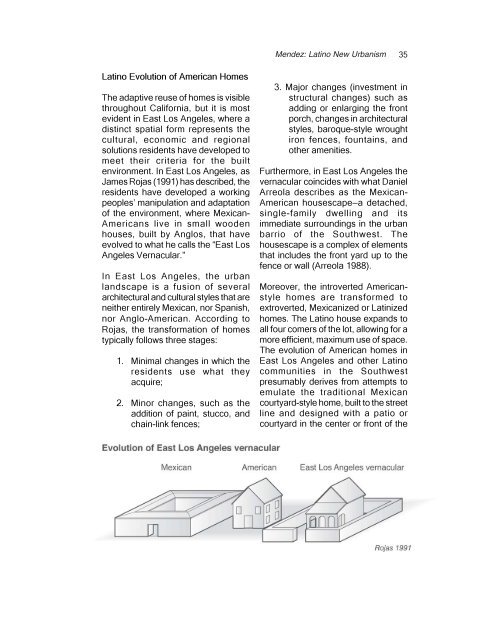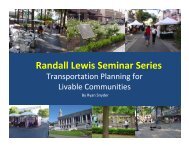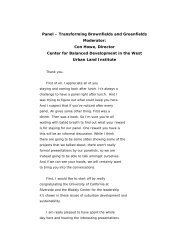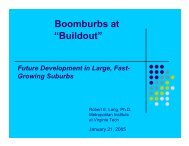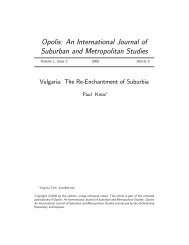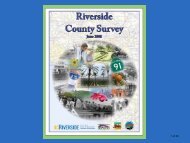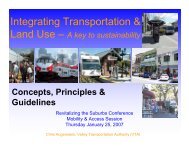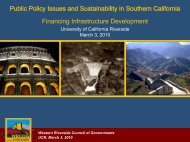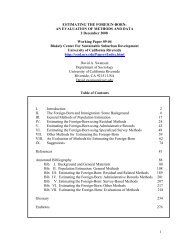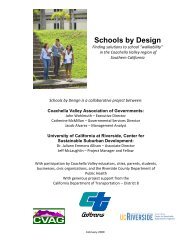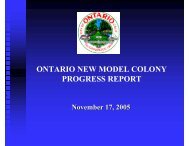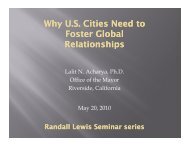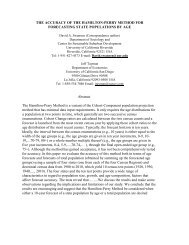Latino New Urbanism: Building on Cultural Preferences - Center for ...
Latino New Urbanism: Building on Cultural Preferences - Center for ...
Latino New Urbanism: Building on Cultural Preferences - Center for ...
You also want an ePaper? Increase the reach of your titles
YUMPU automatically turns print PDFs into web optimized ePapers that Google loves.
<str<strong>on</strong>g>Latino</str<strong>on</strong>g> Evoluti<strong>on</strong> of American Homes<br />
The adaptive reuse of homes is visible<br />
throughout Cali<strong>for</strong>nia, but it is most<br />
evident in East Los Angeles, where a<br />
distinct spatial <strong>for</strong>m represents the<br />
cultural, ec<strong>on</strong>omic and regi<strong>on</strong>al<br />
soluti<strong>on</strong>s residents have developed to<br />
meet their criteria <strong>for</strong> the built<br />
envir<strong>on</strong>ment. In East Los Angeles, as<br />
James Rojas (1991) has described, the<br />
residents have developed a working<br />
peoples’ manipulati<strong>on</strong> and adaptati<strong>on</strong><br />
of the envir<strong>on</strong>ment, where Mexican-<br />
Americans live in small wooden<br />
houses, built by Anglos, that have<br />
evolved to what he calls the “East Los<br />
Angeles Vernacular.”<br />
In East Los Angeles, the urban<br />
landscape is a fusi<strong>on</strong> of several<br />
architectural and cultural styles that are<br />
neither entirely Mexican, nor Spanish,<br />
nor Anglo-American. According to<br />
Rojas, the trans<strong>for</strong>mati<strong>on</strong> of homes<br />
typically follows three stages:<br />
1. Minimal changes in which the<br />
residents use what they<br />
acquire;<br />
2. Minor changes, such as the<br />
additi<strong>on</strong> of paint, stucco, and<br />
chain-link fences;<br />
Mendez: <str<strong>on</strong>g>Latino</str<strong>on</strong>g> <str<strong>on</strong>g>New</str<strong>on</strong>g> <str<strong>on</strong>g>Urbanism</str<strong>on</strong>g><br />
35<br />
3. Major changes (investment in<br />
structural changes) such as<br />
adding or enlarging the fr<strong>on</strong>t<br />
porch, changes in architectural<br />
styles, baroque-style wrought<br />
ir<strong>on</strong> fences, fountains, and<br />
other amenities.<br />
Furthermore, in East Los Angeles the<br />
vernacular coincides with what Daniel<br />
Arreola describes as the Mexican-<br />
American housescape—a detached,<br />
single-family dwelling and its<br />
immediate surroundings in the urban<br />
barrio of the Southwest. The<br />
housescape is a complex of elements<br />
that includes the fr<strong>on</strong>t yard up to the<br />
fence or wall (Arreola 1988).<br />
Moreover, the introverted Americanstyle<br />
homes are trans<strong>for</strong>med to<br />
extroverted, Mexicanized or Latinized<br />
homes. The <str<strong>on</strong>g>Latino</str<strong>on</strong>g> house expands to<br />
all four comers of the lot, allowing <strong>for</strong> a<br />
more efficient, maximum use of space.<br />
The evoluti<strong>on</strong> of American homes in<br />
East Los Angeles and other <str<strong>on</strong>g>Latino</str<strong>on</strong>g><br />
communities in the Southwest<br />
presumably derives from attempts to<br />
emulate the traditi<strong>on</strong>al Mexican<br />
courtyard-style home, built to the street<br />
line and designed with a patio or<br />
courtyard in the center or fr<strong>on</strong>t of the


